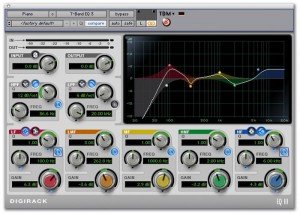Differences between the two most common forms of equalization
As probably the most common for of signal processing, EQ is an essential engineering tool. For new comers to audio, the concept of “EQing” can be a bit overwhelming. As with most things in our industry, you get better at it over time (as your ears develop).
So what is equalization? Basically, it is a tool that lets us control the relative amplitude of particular frequencies found in the audible bandwidth. To put it more simply, EQ allows us to boost or attenuate different tones in a recorded sound. There are many good reasons to use EQ, but there are also just as many not to. In many cases, it boils down to a stylistic thing – some engineers favor equalization during tracking, some do not. For me, starting with a strong performance, good mic placement and a good musician are key. EQ only comes into play if necessary.
Some reasons to uses EQ:
– flatten frequency response of a particular mic
– correct specific problems in a recording
– alter sounds for creative reasons
– blend together contrasting sounds
Reasons not to use EQ:
– easy to get carried away, reducing decent sounds to something worse
– no effects can fix a bad recording
Parametric EQ:
Based around certain parameters, this EQ lets you alter certain frequencies with variable bandwidth and gain. Although models vary, typical designs revolve around variable center frequencies.
This type of EQ is common on many popular recording consoles, as well as being the standard EQ in many major DAW’s. One of the great features of parametric equalization is precise (surgical) cuts or boosts in any frequency without effecting other frequencies. In fact they often overlap.
ProTools Parametric EQ (notice the overlapping frequencies)
Graphic EQ:
Although perhaps not as common on consoles anymore, this type of EQ is very popular in live sound. A graphic EQ allows you to cut or boost levels on equally spaced frequencies (ie. octave). These are usually identifiable by a slew of vertical sliders which theoretically give an overall readout of the frequency response curve.
Graphics are generally found in live sound for feedback control. If using enough bands, it is easy to notch out undesirable frequencies (ex: 60 hz electrical hum). Many popular computer applications, such as iTunes, use a digital graphic EQ for the user to shape the sound.
31 Band Graphic EQ
Which EQ is the right one for the job? That depends on the occasion and personal preference. Generally speaking, parametric EQ has a higher learning curve and can cause more extreme changes in the sound. A graphic EQ is more visual and easier to understand right away. Again, a good practice for audio younglings would be to focus on getting good sounds before you try to change them with equalization or other effects. There are no real short cuts here – it just takes a little time.



